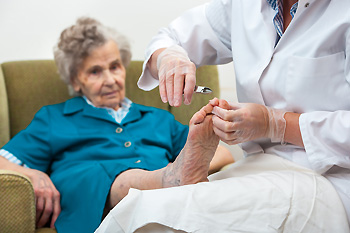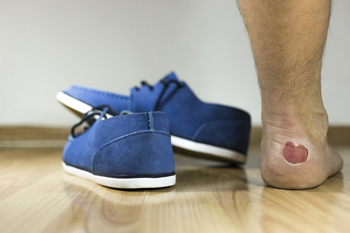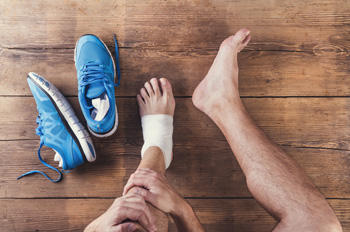Items filtered by date: November 2018
Practicing Daily Foot Care is Important
 It is important to maintain proper care for your feet, and this may be especially true of the elderly population. Research has shown the natural cushioning in the feet may diminish as the aging process occurs, and the toenails and skin may appear to become dry and brittle. There are several ways to practice good foot care, and these may include looking at your feet closely on a frequent basis, which may aid in noticing any blisters or cuts, wearing footwear that feels comfortable, and performing mild stretches, which may improve circulation. Additionally, washing and drying the feet daily may be helpful in preventing or controlling unpleasant foot odor. If you would like additional information about how to take care of elderly feet, please consult with a podiatrist.
It is important to maintain proper care for your feet, and this may be especially true of the elderly population. Research has shown the natural cushioning in the feet may diminish as the aging process occurs, and the toenails and skin may appear to become dry and brittle. There are several ways to practice good foot care, and these may include looking at your feet closely on a frequent basis, which may aid in noticing any blisters or cuts, wearing footwear that feels comfortable, and performing mild stretches, which may improve circulation. Additionally, washing and drying the feet daily may be helpful in preventing or controlling unpleasant foot odor. If you would like additional information about how to take care of elderly feet, please consult with a podiatrist.
Proper foot care is something many older adults forget to consider. If you have any concerns about your feet and ankles, contact Dr. Tupper from Coshocton Foot Health Center. Our doctor can provide the care you need to keep you pain-free and on your feet.
The Elderly and Their Feet
As we age we start to notice many changes in our body, but the elder population may not notice them right away. Medical conditions may prevent the elderly to take notice of their foot health right away. Poor vision is a lead contributor to not taking action for the elderly.
Common Conditions
- Neuropathy – can reduce feeling in the feet and can hide many life-threatening medical conditions.
- Reduced flexibility – prevents the ability of proper toenail trimming, and foot cleaning. If left untreated, it may lead to further medical issues.
- Foot sores – amongst the older population can be serious before they are discovered. Some of the problematic conditions they may face are:
- Gouging toenails affecting nearby toe
- Shoes that don’t fit properly
- Pressure sores
- Loss of circulation in legs & feet
- Edema & swelling of feet and ankles
Susceptible Infections
Diabetes and poor circulation can cause general loss of sensitivity over the years, turning a simple cut into a serious issue.
If you have any questions please feel free to contact our office located in Coshocton, OH . We offer the newest diagnostic and treatment technologies for all your foot and ankle needs.
Orthotics May Help Specific Types of Foot Pain
 Foot pain may occur for several different reasons. Helpful aids may include wearing orthotics, which may alleviate a portion of the pain and discomfort. They are described as an insert that is placed inside the shoes and may provide the additional support and stability that is needed. There are specific kinds of orthotics that are used, and the correct type that is needed is generally determined by the type of foot pain that is experienced. Some of the conditions that are treated with these devices may include plantar fasciitis, bunions, or rheumatoid arthritis. If you have foot pain and would like additional information about the benefits of orthotics, it is suggested to consult with a podiatrist who is able to provide the answers you are seeking.
Foot pain may occur for several different reasons. Helpful aids may include wearing orthotics, which may alleviate a portion of the pain and discomfort. They are described as an insert that is placed inside the shoes and may provide the additional support and stability that is needed. There are specific kinds of orthotics that are used, and the correct type that is needed is generally determined by the type of foot pain that is experienced. Some of the conditions that are treated with these devices may include plantar fasciitis, bunions, or rheumatoid arthritis. If you have foot pain and would like additional information about the benefits of orthotics, it is suggested to consult with a podiatrist who is able to provide the answers you are seeking.
If you are having discomfort in your feet and would like to try orthotics, contact Dr. Tupper from Coshocton Foot Health Center. Our doctor can provide the care you need to keep you pain-free and on your feet.
What Are Orthotics?
Orthotics are inserts you can place into your shoes to help with a variety of foot problems such as flat feet or foot pain. Orthotics provide relief and comfort for minor foot and heel pain but can’t correct serious biomechanical problems in your feet.
Over-the-Counter Inserts
Orthotics come in a wide variety of over-the-counter inserts that are used to treat foot pain, heel pain, and minor problems. For example, arch supports can be inserted into your shoes to help correct overarched or flat feet, while gel insoles are often used because they provide comfort and relief from foot and heel pain by alleviating pressure.
Prescription Orthotics
If over-the-counter inserts don’t work for you or if you have a more severe foot concern, it is possible to have your podiatrist prescribe custom orthotics. These high-quality inserts are designed to treat problems such as abnormal motion, plantar fasciitis, and severe forms of heel pain. They can even be used to help patients suffering from diabetes by treating foot ulcers and painful calluses and are usually molded to your feet individually, which allows them to provide full support and comfort.
If you are experiencing minor to severe foot or heel pain, it’s recommended to speak with your podiatrist about the possibilities of using orthotics. A podiatrist can determine which type of orthotic is right for you and allow you to take the first steps towards being pain-free.
If you have any questions please contact our office located in Coshocton, OH . We offer the newest diagnostic and treatment technologies for all your foot and ankle needs.
Different Types of Blisters on the Feet
 A common reason why blisters form on the feet may be a result of consistent friction between the toes or on the back of the heel. A blister is typically a small area that resembles a bubble and is filled with fluid. This is the body’s natural defense mechanism to ensure the skin under the blister is protected. Research has shown there are different types of blisters that may form, including pinch blisters, which may be a result of a toe that is curled under the toe next to it, causing a blister to form in between the two toes. Additionally, interdigital blisters may be caused by an allergic reaction to an insect bite, and may lead to an infection. Patients who have eczema or athlete's foot may be familiar with the types of blisters these uncomfortable conditions may cause. If shoes that are worn do not fit correctly, blisters may form on the pinky toe or if excess rubbing exists on the back of the foot, it may cause unsightly blisters on the back of the heel. If you would like to learn about how to prevent blisters on the feet or need information about proper treatment techniques, it’s suggested to speak with a podiatrist.
A common reason why blisters form on the feet may be a result of consistent friction between the toes or on the back of the heel. A blister is typically a small area that resembles a bubble and is filled with fluid. This is the body’s natural defense mechanism to ensure the skin under the blister is protected. Research has shown there are different types of blisters that may form, including pinch blisters, which may be a result of a toe that is curled under the toe next to it, causing a blister to form in between the two toes. Additionally, interdigital blisters may be caused by an allergic reaction to an insect bite, and may lead to an infection. Patients who have eczema or athlete's foot may be familiar with the types of blisters these uncomfortable conditions may cause. If shoes that are worn do not fit correctly, blisters may form on the pinky toe or if excess rubbing exists on the back of the foot, it may cause unsightly blisters on the back of the heel. If you would like to learn about how to prevent blisters on the feet or need information about proper treatment techniques, it’s suggested to speak with a podiatrist.
Blisters may appear as a single bubble or in a cluster. They can cause a lot of pain and may be filled with pus, blood, or watery serum. If your feet are hurting, contact Dr. Tupper of Coshocton Foot Health Center. Our doctor can provide the care you need to keep you pain-free and on your feet.
Foot Blisters
Foot blisters are often the result of friction. This happens due to the constant rubbing from shoes, which can lead to pain.
What Are Foot Blisters?
A foot blister is a small fluid-filled pocket that forms on the upper-most layer of the skin. Blisters are filled with clear fluid and can lead to blood drainage or pus if the area becomes infected.
Symptoms
(Blister symptoms may vary depending on what is causing them)
- Bubble of skin filled with fluid
- Redness
- Moderate to severe pain
- Itching
Prevention & Treatment
In order to prevent blisters, you should be sure to wear comfortable shoes with socks that cushion your feet and absorb sweat. Breaking a blister open may increase your chances of developing an infection. However, if your blister breaks, you should wash the area with soap and water immediately and then apply a bandage to the affected area. If your blisters cause severe pain it is important that you call your podiatrist right away.
If you have any questions, please feel free to contact our office located in Coshocton, OH . We offer the newest diagnostic and treatment technologies for all your foot care needs.
Symptoms Of Tarsal Tunnel Syndrome
 The medical condition that is referred to as tarsal tunnel syndrome typically affects the ligaments that stretch across the foot. These are known to provide flexibility and stability to the foot, and may become irritated and inflamed if they are compressed. This may occur as a result from an injury or trauma the foot endures, possibly due to performing repetitive motions. There are several symptoms that are associated with this condition. Many patients will notice a burning or tingling sensation in their foot and may also be accompanied by a shooting pain in the ankle. If you have injured your foot or have pain in the ankle that develops gradually, it’s suggested to speak with a podiatrist so a proper diagnosis can be performed, and the correct treatment can begin.
The medical condition that is referred to as tarsal tunnel syndrome typically affects the ligaments that stretch across the foot. These are known to provide flexibility and stability to the foot, and may become irritated and inflamed if they are compressed. This may occur as a result from an injury or trauma the foot endures, possibly due to performing repetitive motions. There are several symptoms that are associated with this condition. Many patients will notice a burning or tingling sensation in their foot and may also be accompanied by a shooting pain in the ankle. If you have injured your foot or have pain in the ankle that develops gradually, it’s suggested to speak with a podiatrist so a proper diagnosis can be performed, and the correct treatment can begin.
Tarsal tunnel syndrome can be very uncomfortable to live with. If you are experiencing tarsal tunnel syndrome, contact Dr. Tupper of Coshocton Foot Health Center. Our doctor can provide the care you need to keep you pain-free and on your feet.
Tarsal Tunnel Syndrome
Tarsal tunnel syndrome, which can also be called tibial nerve dysfunction, is an uncommon condition of misfiring peripheral nerves in the foot. The tibial nerve is the peripheral nerve in the leg responsible for sensation and movement of the foot and calf muscles. In tarsal tunnel syndrome, the tibial nerve is damaged, causing problems with movement and feeling in the foot of the affected leg.
Common Cause of Tarsal Tunnel Syndrome
- Involves pressure or an injury, direct pressure on the tibial nerve for an extended period of time, sometimes caused by other body structures close by or near the knee.
- Diseases that damage nerves, including diabetes, may cause tarsal tunnel syndrome.
- At times, tarsal tunnel syndrome can appear without an obvious cause in some cases.
The Effects of Tarsal Tunnel Syndrome
- Different sensations, an afflicted person may experience pain, tingling, burning or other unusual sensations in the foot of the affected leg.
- The foot muscles, toes and ankle become weaker, and curling your toes or flexing your foot can become difficult.
- If condition worsens, infections and ulcers may develop on the foot that is experiencing the syndrome.
A physical exam of the leg can help identify the presence of tarsal tunnel syndrome. Medical tests, such as a nerve biopsy, are also used to diagnose the condition. Patients may receive physical therapy and prescriptive medication. In extreme cases, some may require surgery.
If you have any questions please feel free to contact our office located in Coshocton, OH . We offer the newest diagnostic and treatment technologies for all your foot and ankle needs.


